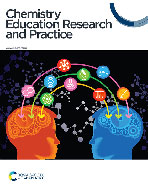Chemistry self-efficacy in lower-division chemistry courses: changes after a semester of instruction and gaps still remain between student groups
Abstract
Chemistry self-efficacy (CSE) was identified as a critical affective construct to predict student success in chemistry classrooms. We surveyed students at the beginning and toward the end of a semester to measure students’ CSE beliefs in introductory and general chemistry courses at a Hispanic-serving institution in the United States. First, the relationships between CSE (initial and toward the end) and student achievement measured by course GPA were examined. Second, trends of changes in student CSE beliefs over a semester in relation to several aspects of student characteristics including course level, gender, underrepresented minority (URM) status were investigated. Lastly, the gaps in specific areas of CSE still remain between student groups after a semester of instruction were revealed. The results showed that CSE toward the end of the semester significantly predicted students’ course GPA in lower-division chemistry courses. Even though the CSE of different student groups all increased to some extent after a semester of instruction, the levels of changes were influenced significantly by certain factors such as course level and URM status but not gender. While URM students' CSE beliefs increased more than non-URM students after a semester of instruction, there were still gaps in certain areas between the two student groups. The remaining gaps in CSE beliefs between URM and non-URM students were found to be in the areas of interpreting chemical equations and choosing appropriate formulas to solve chemistry problems. Meanwhile, students who completed introductory chemistry still lagged behind in interpreting chemical equations as compared to students who completed general chemistry. Research literature related to these two specific areas in CSE with gaps between student groups was reviewed, instructional strategies and research directions along with theoretical perspectives for closing those equity gaps in college lower-division chemistry classrooms are discussed.


 Please wait while we load your content...
Please wait while we load your content...